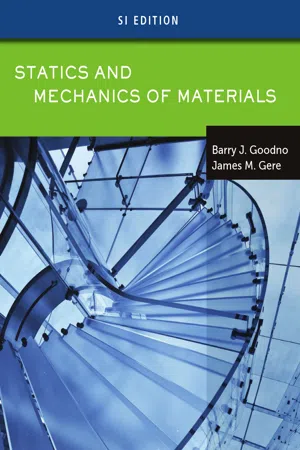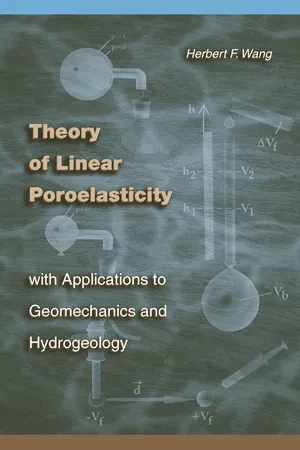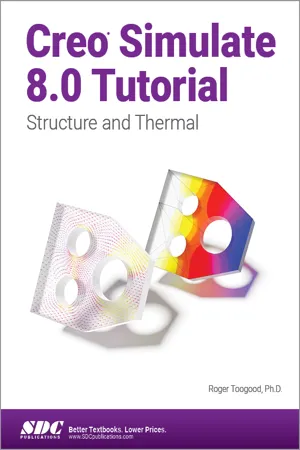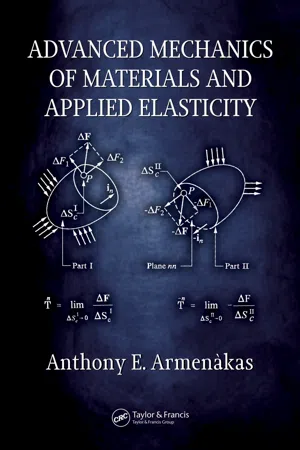Technology & Engineering
Plane Stress vs Plane Strain
Plane stress and plane strain are concepts used in the field of solid mechanics to describe the behavior of materials under different loading conditions. Plane stress occurs when a material is subjected to forces in a single plane, leading to deformation only in that plane. Plane strain, on the other hand, occurs when a material experiences deformation in all directions within a plane, typically due to three-dimensional loading.
Written by Perlego with AI-assistance
Related key terms
1 of 5
7 Key excerpts on "Plane Stress vs Plane Strain"
- Barry Goodno, James Gere(Authors)
- 2018(Publication Date)
- Cengage Learning EMEA(Publisher)
Furthermore, keep in mind that stresses are not vectors. This fact can some- times be confusing, because engineers customarily represent stresses by arrows just as they represent force vectors by arrows. Although the arrows used to rep- resent stresses have magnitude and direction, they are not vectors because they do not combine according to the parallelogram law of addition. Instead, stresses are much more complex quantities than are vectors, and in mathematics, they are called tensors. Other tensor quantities in mechanics are strains and moments of inertia. 11.2 Plane Stress The stress conditions encountered in earlier chapters when analyzing bars in tension and compression, shafts in torsion, and beams in bending are exam- ples of a state of stress called plane stress. To explain plane stress, consider Copyright 2019 Cengage Learning. All Rights Reserved. May not be copied, scanned, or duplicated, in whole or in part. Due to electronic rights, some third party content may be suppressed from the eBook and/or eChapter(s). Editorial review has deemed that any suppressed content does not materially affect the overall learning experience. Cengage Learning reserves the right to remove additional content at any time if subsequent rights restrictions require it. Section 11.2 Plane Stress 831 the stress element shown in Fig. 11-1a. This element is infinitesimal in size and can be sketched either as a cube or as a rectangular parallelepiped. The xyz axes are parallel to the edges of the element, and the faces of the element are designated by the directions of their outward normals, as explained previously in Section 7.6. For instance, the right-hand face of the element is referred to as the positive x face, and the left-hand face (hidden from the viewer) is referred to as the negative x face. Similarly, the top face is the positive y face, and the front face is the positive z face.- Wole Soboyejo(Author)
- 2002(Publication Date)
- CRC Press(Publisher)
3 ________________________ Basic Definitions of Stress and Strain 3.1 INTRODUCTION The mechanical properties of materials describe their characteristic responses to applied loads and displacements. However, most texts relate the mechanical properties of materials to stresses and strains. It is, therefore, important for the reader to become familiar with the basic definitions of stress and strain before proceeding on to the remaining chapters of this book. However, the well-prepared reader may choose to skip/skim this chapter, and then move on to Chap. 4 in which the fundamentals of elas-ticity are introduced. The basic definitions of stress and strain are presented in this chapter along with experimental methods for the measurement and application of strain and stress. The chapter starts with the relationships between applied loads/displacements and geometry that give rise to the basic definitions of strain and stress. Simple experimental methods for the measurement of strain and stress are then presented before describing the test machines that are often used for the application of strain and stress in the laboratory. 3.2 BASIC DEFINITIONS OF STRESS The forces applied to the surface of a body may be resolved into compo-nents that are perpendicular or parallel to the surface, Figs 3.1(a)-3.1(c). In 59 (a) 60 (b) Chapter 3 Simple tension,- Herbert F. Wang(Author)
- 2017(Publication Date)
- Princeton University Press(Publisher)
7 Plane Strain and Plane Stress in Rectangular Coordinates 7.0 CHAPTER OVERVIEW Geomechanics problems, such as loading by a reservoir lake or seabed struc- ture that is infinitely extensive in one direction on the earth’s surface, can be represented by a perpendicular cross section in a state of plane strain. Geome- chanics problems, such as water-level changes due to solid earth tides, can be interpreted assuming that a horizontal layer is in a state of plane stress. Boundary-value problems for a half space in plane strain subjected to peri- odic or sudden loading have been solved using stress or displacement func- tions introduced by Biot (1956d). The advantage of stress or displacement functions is that their governing equations are uncoupled. The stress or dis- placement components are recovered as partial derivatives of the stress or displacement functions, respectively. Verruijt (1971) showed that McNamee and Gibson’s (1960a, 1960b) displacement functions E and S used to solve the plane-strain problem of a suddenly applied load on the surface of a half space are a special case of Biot’s. Representative problems in plane strain considered in this chapter include (1) Mandel’s (1953) problem, which is the canonical demonstration of how poroelastic coupling can produce nonmonotonic pore-pressure behavior fol- lowing undrained loading 1 ; (2) mechanical loading of a drained half space (Biot, 1941b; McNamee and Gibson, 1960b; Verruijt, 1971; Roeloffs, 1988); (3) fluid extraction from a long line of wells (Segall, 1985); and (4) shear slip on faults (Booker, 1974; Rice and Cleary, 1976; Roeloffs and Rudnicki, 1984/85; Rudnicki, 1986b, 1987; Rudnicki and Hsu, 1988; Rudnicki and Roeloffs, 1990). 1 This phenomenon is called the Mandel-Cryer effect, because Cryer (1963) showed that the hydrostatic loading of a sphere induces similar nonmonotonic pore-pressure behavior at the center of the sphere.- eBook - PDF
Creo Simulate 8.0 Tutorial
Structure and Thermal
- Roger Toogood Ph.D.(Author)
- 2021(Publication Date)
- SDC Publications(Publisher)
Plane Stress / Plane Strain 5 - 1 Chapter 5 : Plane Stress and Plane Strain Models Overview of this Lesson As demonstrated in the previous two chapters, the default model type is a 3D solid, for which the finite element model is composed of tetrahedral elements. For many FEA problems, however, treating them as solids is “overkill.” Useful results can often be obtained much more efficiently by treating a simplified version of the problem using idealizations. For example, the essence of the problem might be expressed using only a two dimensional planar geometry. This is the subject of this lesson. Other idealizations (shells, axisymmetric solids and shells, beams) are treated in the next few lessons. Although Creo is by nature a 3D modeler, you can easily treat 2D FEA problems. These include models for plane stress and plane strain based on the geometry contained in the 3D model. For plane stress and plane strain, as the name implies, the geometry of interest is contained in a planar surface that is “extracted” from the 3D model. The solution is obtained using planar elements (quadrilaterals and triangles) instead of tetrahedral solid elements. For all problems based on 2D geometry, some restrictions and additional points need to be considered: 1. All surfaces used to define the geometry for the FEA model must be co- planar. No surprise there, but what this means is you cannot project another surface onto the FEA model plane. 2. The geometry must have an associated Cartesian coordinate system. This can be created in Creo Simulate and does not have to align or be parallel with the default or WCS axes - it can be any orientation in 3D space. 3. All entities for the model must be in the XY plane of the coordinate system. This includes all model geometry, constraints, and loads. 4. For axisymmetric models (these are also 2D models), the model must all be on the positive X side of the coordinate system, X > 0. - Anthony E. Armenakas(Author)
- 2016(Publication Date)
- CRC Press(Publisher)
271 (7.1) (7.2) (7.3) (7.4) Chapter 7 Plane Strain and Plane Stress Problems in Elasticity 7.1 Plane Strain In this section we consider prismatic (multiply or simply connected) bodies made from 1 isotropic, linearly elastic materials and we choose the x axis to coincide with the locus of the centroid of their cross sections. The bodies are originally in a stress-free, strain-free o state of mechanical and thermal equilibrium at the uniform temperature T . Subsequently, the bodies are subjected to specified specific body forces and to specified boundary conditions and reach a second state of mechanical and thermal equilibrium at the uniform o 1 temperature T in which the component of displacement u vanishes while their other two 2 3 components of displacement are functions of only x and x . We say that these bodies are in a state of plane strain . Referring to the strain–displacement relations (2.16) the components of strain of these bodies are Referring to the stress-strain relations for a state of plane strain (3.50), we see that Substituting relations (7.2) into the equilibrium equations (2.69), we have 2 3 Inasmuch as the components of stress are only functions of x and x , referring to relations (7.3), we see that in order to have a state of plane strain in a body the distribution of the specific body force must have the following form: Plane Strain and Plane Stress Problems in Elasticity 272 (7.5a) (7.5b) (7.5c) (7.6) Figure 7.1 Prismatic body in a state of plane strain. The stress distribution (7.2) when substituted into the traction–stress relations (2.73) must give components of traction which when evaluated at the points of the boundary of the body where components of traction are specified give the specified components of traction. Referring to Fig. 7.1 the unit vector outward normal to the lateral surfaces of a prismatic body is .- eBook - PDF
- William F. Riley, Leroy D. Sturges, Don H. Morris(Authors)
- 2018(Publication Date)
- Wiley(Publisher)
Chapter 3 Analysis of Strain: Concepts and Definitions 3-1 INTRODUCTION Relationships were developed in Chapter 2 between forces and stresses and between stresses on planes having different orientations at a point using equi- librium considerations. No assumptions involving deformations or materials used in fabricating the body were made; therefore, the results are valid for an idealized rigid body or for a real deformable body. In the design of structural elements or machine components, the deformations experienced by the body, as a result of the applied loads, often represent as important a design consideration as the stresses. For this reason, the nature of the deformations experienced by a real deformable body as a result of internal force or stress distributions will be studied, and methods to measure or compute deformations will be established. 3-2 DISPLACEMENT, DEFORMATION, AND STRAIN 3-2-1 Displacement When a system of loads is applied to a machine component or structural element, individual points of the body generally move. This movement of a point with respect to some convenient reference system of axes is a vector quantity known as a displacement. For example, consider a body where displacements are restricted to the x–y plane. In Fig. 3-1 the solid lines represent a body before loads are applied, and the dashed lines represent the body after loads are applied and the body has deformed. Line AB of initial length L i has deformed into a line of final length L f . Point A is displaced to point A . The vector from A to A is called the displacement of point A. For this two- dimensional example, the scalar components of the displacement vector are u A in the x-direction and v A in the y-direction. If L i = L f , the body is rigid; and if L i = L f , the body has deformed. In some instances, displacements are associated with a translation and/or a rotation of the body as a whole and neither the size nor the shape of the body is changed. - eBook - PDF
Strength of Materials
A New Unified Theory for the 21st Century
- Surya Patnaik, Dale Hopkins(Authors)
- 2003(Publication Date)
- Butterworth-Heinemann(Publisher)
We will assume that it has been analyzed as a membrane 441 structure. In such an analysis, the stress state is considered to be uniform across the thickness and only three stress components are induced. These are the two normal stresses ( s x , s y ) and a shear stress, which is symmetrical ( t xy t yx t ). The membrane stress state ( s x , s y , t xy ) is also referred to as the plane stress, or two-dimensional, stress state. The three stress components at the plate centroid C are marked on an elemental block ( A ± B ± C ± D ) in Fig. 10-1 c . The values of the stresses are approximate because an elementary model was employed for its analysis. The normal tensile stress along the x -direction is s x 666 psi. The normal compressive stress along the y -direction is s y 325 psi. The shear stress in the x ± y plane is t xy 1000 psi. 10.2 Plane Stress State The three components of the plane stress state can be arranged to obtain a (2 2) stress matrix [ t ] as t s x t xy t xy s y t xx t xy t yx t yy s x t t s y 10-1 (a) Plate. D C A B z O C y (c) Stress at location C . (b) Cross-section. 666 y = –325 t = 0.25 in. t x y xy = 1000 x = 666 psi 6 in. 12 in. 1.5 kip 1.0 kip 4 3 1 2 FIGURE 10-1 Stress in a rectangular plate. 442 STRENGTH OF MATERIALS The components of the stress tensor [ t ] can be written with two subscripts ( i , j ), such as t ij , as marked on the elemental block A ± B ± C ± D in Fig. 10-2. Elasticity analysis prefers numerical subscripts ( i 1 or 2, and j 1 or 2). We will use engineering notation ( i x or y , and j x or y ), with x and y representing the coordinates, respectively. The stress tensor is described with the following convention. 1. In the elemental block ( A ± B ± C ± D ) in Fig. 10-2, the face BC is referred to as the positive x -face because the normal ( n ) to this face ( n BC 1) is directed along the x -coordinate axis.
Index pages curate the most relevant extracts from our library of academic textbooks. They’ve been created using an in-house natural language model (NLM), each adding context and meaning to key research topics.






